Practicing the Bridges in Mathematics Grade 4 Student Book Answer Key Unit 6 Module 3 will help students analyze their level of preparation.
Bridges in Mathematics Grade 4 Student Book Answer Key Unit 6 Module 3
Bridges in Mathematics Grade 4 Student Book Unit 6 Module 3 Session 1 Answer Key
Swimming Pool Times
The school choir is planning their annual Swimming Pool Fundraiser where they sell tickets for a special party at a nearby pool. Last year Ben kept track of how long people stayed in the pool. He began to calculate each person’s total time and he plotted the first five times on the line plot, but he hasn’t finished yet.
Question 1.
Fill in the rest of the values in the last column of the chart.
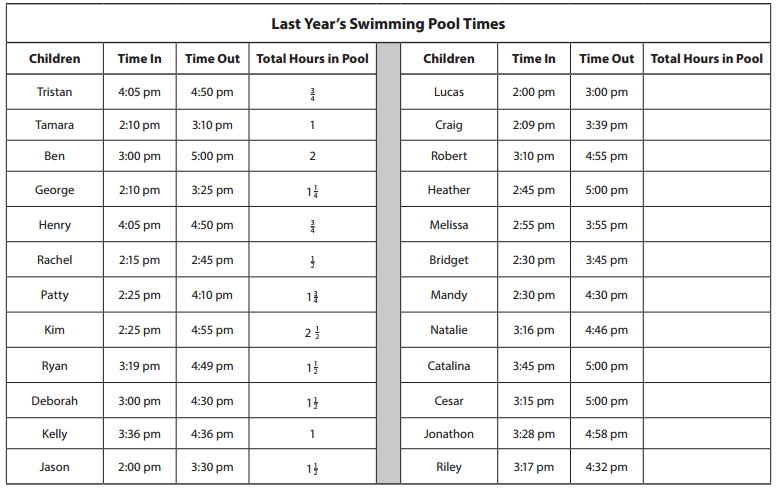
Answer:

Explanation:
Ben calculated each person’s total time and filled in the rest of the values in the last column of the chart.
Question 2.
Complete the line plot Ben started using the data from the chart.

Answer:

Explanation:
We have completed the line plot Ben started using the data from the chart. Check the figure.
Analyzing the Line Plot
Question 3.
Calculate the total amount of time spent in the pool by the first five children.
Answer:
The total amount of time spent in the pool by the five children is 5\(\frac{3}{4}\).
Explanation:
\(\frac{3}{4}\) + 1 + 2 + 1 \(\frac{1}{4}\) + \(\frac{3}{4}\)
\(\frac{3}{4}\) + 1 + 2 + \(\frac{5}{4}\) + \(\frac{3}{4}\)
Take LCM of 4
\(\frac{(3+4+8+5+3)}{4}\)
\(\frac{23}{4}\)
5\(\frac{3}{4}\)
Question 4.
Complete the following using the line plot above.
a. Circle and label the minimum and maximum amount of time spent in the pool.
Answer:
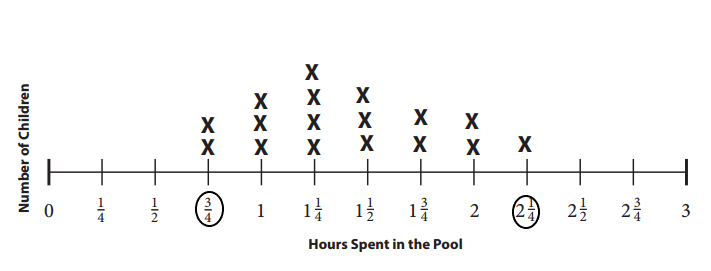
Explanation:
We have circled and labelled the minimum and maximum amount of time spent in the pool.
b. Determine and label the range, or the difference between the greatest and least value in the data. The range is ______________.
Answer:
The difference between the greatest and least value in the data is \(\frac{1}{4}\).
Explanation:
We know,
The greatest value is \(\frac{3}{4}\)
The least value is \(\frac{1}{4}\)
The difference between is \(\frac{3}{4}\) – \(\frac{1}{4}\)
\(\frac{2}{4}\) = \(\frac{1}{4}\)
c. Find the mode, or value that appears most often. The mode is ____________.
Answer:
The mode is 1\(\frac{1}{4}\).
Explanation:
From the line plot the value that appears most often is 1\(\frac{1}{4}\).
d. Find the middle value, or median. The median is ____________.
Answer:
The median is 1\(\frac{1}{2}\).
Explanation:
The middle value or median is 1\(\frac{1}{2}\).
Factors & Multiples Moves
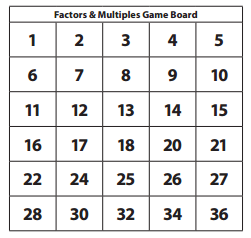
Question 1.
Jasmine and Briana are playing Factors & Multiples. Jasmine chose 27 as her first target number and circled it. Briana gets to circle all of the factors of 27. What numbers does Briana get to circle?
Answer:
The numbers Briana gets to circle are 1, 3, 9 and 27.
Explanation:
Given,
Jasmine chose 27 as her first target number.
Briana gets to circle all of the factors of 27.
So the factors of 27 are 1, 3, 9 and 27.
Therefore Briana circled all the factors in the figure.

Question 2.
Danny and Justin are also playing Factors & Multiples. Danny’s first target number is 24. What numbers does Justin get to circle?
Answer:
The numbers Justin gets to circle are 1, 2, 3, 4, 6, 8, 12 and 24.
Explanation:
Here we have to find the factors of 24.
The factors of 24 are 1, 2, 3, 4, 6, 8, 12 and 24.

Question 3.
Bethany circled 1, 2, 4, and 8. What target number did Bethany’s partner choose?
Answer:
Bethany’s partner choose 8 as the target number.
Explanation:
Given,
The factors are 1, 2, 4, and 8.
We need to find target number did Bethany’s partner choose.
Therefore the target number is 8.
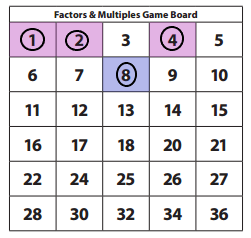
Question 4.
After Oscar chose his target number, his partner circled 1, 2, 3, 4, and 6. What was Oscar’s target number?
Answer:
The Oscar’s target number is 12.
Explanation:
Given,
his partner circled 1, 2, 3, 4, and 6.
we have to find Oscar’s target number.
The given numbers are multiples of 12.
Hence the Oscar’s target number is 12.
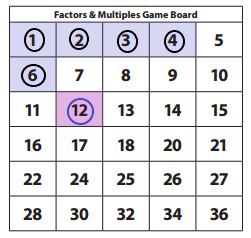
Question 5.
Aaron is trying to decide if he wants to choose 14 or 18 as his first target number. Which number would give him a higher score than his partner? Explain your thinking.
Answer:
The number that would give him a higher score than his partner is 18. The factors of 18 are 1, 2, 3, 6, 9 and 18.
Explanation:
Given,
The numbers are 14 and 18.
He has to choose one number as his target number.
The number that would give him a higher score than his partner is 1, 2, 3, 6, 9 and 18.
Question 6.
List the prime numbers that are on the Factors & Multiples Game Board.
Answer:
The prime numbers that are on the Factors & Multiples Game Board are 1, 2, 3, 5, 7, 11, 13, 17.
Explanation:
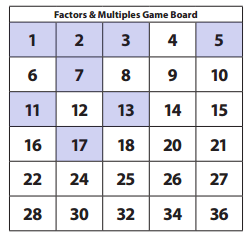
Bridges in Mathematics Grade 4 Student Book Unit 6 Module 3 Session 2 Answer Key
The Swimming Contest
Sixteen of the kids who came to the Swimming Pool Fundraiser had a contest to see how many laps they could each swim in five minutes.
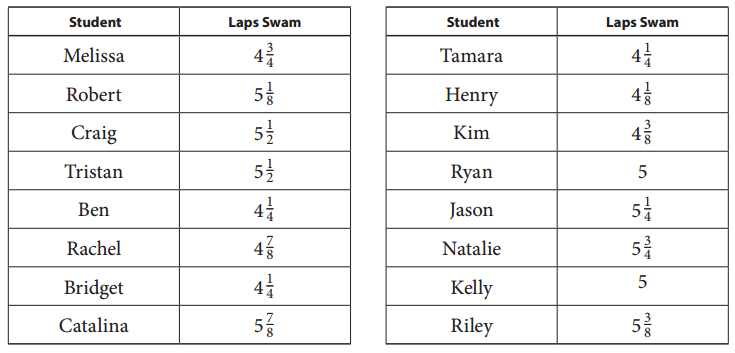
Question 1.
Enter the data on the line plot below.

Answer:
Here, we have plotted the data on the number plot below.
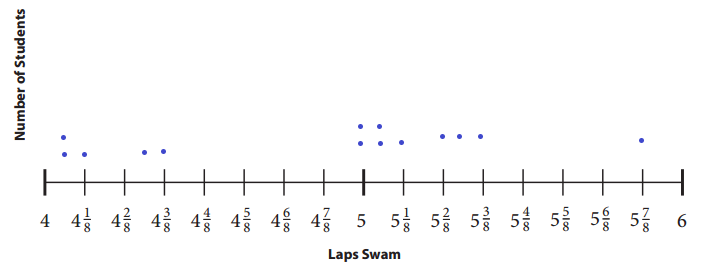
Question 2.
How many students swam 5\(\frac{1}{8}\) laps or more?
Answer:
There are 7 students that swam 5\(\frac{1}{8}\) laps or more.
Question 3.
How many students swam fewer than 5 laps?
Answer:
No of students that swam fewer than 5 laps are 7.
Question 4.
What is the mode of this data?
Answer:
The mode is 4\(\frac{1}{4}\).
Explanation:
The mode of this given data is 4\(\frac{1}{4}\).
Question 5.
Find the range of the data (the difference between the fewest and the most laps). Show your work.
Answer:
The difference between the range of data is \(\frac{3}{2}\).
Explanation:
The fewest laps are 4\(\frac{3}{8}\) and the most laps are 5\(\frac{7}{8}\).
The difference between them is 5\(\frac{7}{8}\) – 4\(\frac{3}{8}\)
\(\frac{47}{8}\) – \(\frac{35}{8}\)
\(\frac{12}{8}\)
\(\frac{3}{2}\)
Snail Race
Cindy had a collection of snails. She wanted to see which snail could travel the farthest in one minute. Below is a table showing the distance each snail traveled.

Question 1.
Complete the line plot below to display the information shown in the chart and then answer the questions that follow. Be sure to finish labeling all of the marks along the line before you plot the data points.
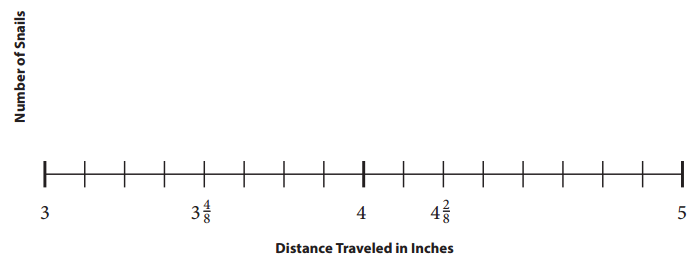
Answer:

Explanation:
We have completed the line plot below to display the information shown in the chart and then answer the questions that follow by labeling all of the marks along the line before you plot the data points.
Question 2.
What is the shortest (minimum) distance?
Answer:
3\(\frac{6}{8}\) or 3\(\frac{3}{4}\) inches.
Explanation:
The shortest distance from the given figure is 3\(\frac{6}{8}\) or 3\(\frac{3}{4}\) inches.
Question 3.
What is the longest (maximum) distance?
Answer:
4\(\frac{7}{8}\) inches.
Explanation:
The longest distance from the given figure is 4\(\frac{7}{8}\) inches.
Question 4.
What is the difference between the shortest and longest distance (range)? Show your work.
Answer:
1\(\frac{1}{8}\) inches.
Explanation:
Given,
The shortest distance is 3\(\frac{6}{8}\).
The longest distance is 4\(\frac{7}{8}\) inches.
The difference between them is 4\(\frac{7}{8}\) – 3\(\frac{6}{8}\)
\(\frac{39}{8}\) – \(\frac{30}{8}\)
\(\frac{(39 – 30)}{8}\)
\(\frac{9}{8}\)
1\(\frac{1}{8}\) inches.
Question 5.
Which distance appears most often (mode)?
Answer:
4\(\frac{2}{8}\) inches or 4\(\frac{1}{4}\) inches.
Explanation:
The distance appears most often in the given figure is 4\(\frac{2}{8}\) inches or 4\(\frac{1}{4}\) inches.
Question 6.
Which distance is the middle value of all the measurements (median)?
Answer:
4\(\frac{3}{8}\) inches.
Explanation:
The distance that is the middle value of all the measurements is 4\(\frac{3}{8}\) inches.
Bridges in Mathematics Grade 4 Student Book Unit 6 Module 3 Session 3 Answer Key
Work Place Instructions 6C Fraction Spin & Add
Each pair of players needs:
- 6C Fraction Spin & Add Record Sheets (1 for each player)
- pattern blocks
- 1 spinner overlay
1. Players determine who will be Player 1 and Player 2 and write their names on their record sheets.
2. Player 1 spins the spinner twice and adds the two spins (fractions) together.
3 Player 1 then finds pattern blocks to represent the sum of the fractions and places them on the first row of hexagons on his record sheet.
4. Player 2 takes a turn and repeats steps 3 and 4.
5. Whenever possible, players must “trade up” to have the fewest pattern blocks possible.

Player 2 OK, first I landed on \(\frac{1}{3}\), and then I landed on \(\frac{1}{6}\). I know a blue rhombus is \(\frac{1}{3}\) of a hexagon, and a triangle is \(\frac{1}{6}\). If you put those together, they make a trapezoid, which is half a hexagon.
6. The first player to fill all six hexagons wins. If Player 1 wins, Player 2 gets one more turn to try to make it a tie game. Going over six hexagons is allowed.
Game Variations
A. Students spin only one time and place pattern block pieces on the record sheet.
B. The game continues until one player fills up the six hexagons exactly without going over.
C. Players record their moves (spins and trades) by writing fraction addition equations.
D. Players start with six whole hexagons, spin, and subtract pieces until they are left with none. Players record subtraction equations.
Answer:
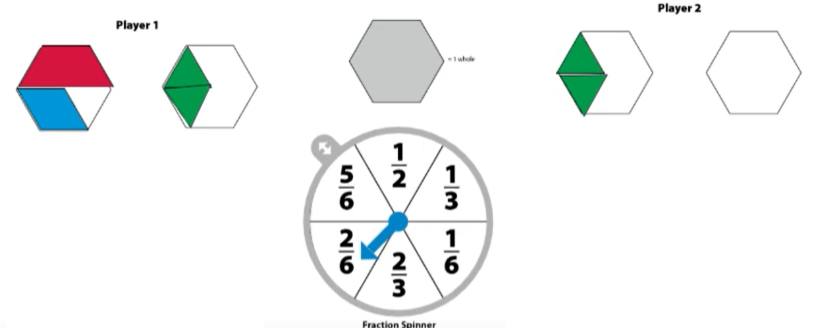
Playing Fraction Spin & Add
Question 1.
Melinda is playing Fraction Spin & Add. She spins \(\frac{1}{6}\) and \(\frac{2}{3}\).
a. What is the sum of Melinda’s spins?
Answer:
The sum of Melinda’s spins is \(\frac{5}{6}\)
Explanation:
Given,
The spins are \(\frac{1}{6}\) and \(\frac{2}{3}\).
Now we need to add both of them.
\(\frac{1}{6}\) + \(\frac{2}{3}\)
\(\frac{(1 + 4)}{6}\)
\(\frac{5}{6}\)
b. What pattern blocks should she put on her record sheet so she uses the fewest pieces?
Answer:
One hexagon and two Trapezoids.
Explanation:
Given,
To represent \(\frac{1}{6}\) and \(\frac{4}{6}\) using pattern blocks.
Melinda can use one hexagon that represent \(\frac{1}{6}\) and the trapezoid that represent \(\frac{2}{6}\).
Therefore Melinda uses one hexagon and two Trapezoids pattern blocks should she put on her record sheet so she uses the fewest pieces.
Question 2.
Now it’s Kevin’s turn. He spins \(\frac{2}{3}\) and \(\frac{5}{6}\).
a. What is the sum of Kevin’s spins?
Answer:
The sum of Kevin’s spins is \(\frac{3}{2}\).
Explanation:
Given,
The spins are \(\frac{2}{3}\) and \(\frac{5}{6}\).
Now add the both spins.
\(\frac{2}{3}\) + \(\frac{5}{6}\)
The LCM is 6.
\(\frac{(4 + 5)}{6}\)
\(\frac{9}{6}\)
\(\frac{3}{2}\)
b. What pattern blocks should he put on his record sheet so he uses the fewest pieces?
Answer:
Kevin should use the pattern blocks are \(\frac{2}{3}\), \(\frac{2}{12}\) and 1\(\frac{1}{2}\) blocks.
Explanation:
Given,
He spins \(\frac{2}{3}\) and \(\frac{5}{6}\).
Therefore Kevin should use the pattern blocks are \(\frac{2}{3}\), \(\frac{2}{12}\) and 1\(\frac{1}{2}\) blocks.
So a total of 4 blocks, which is the fewest number of blocks needed.
Question 3.
Ryan and Elizabeth are also playing Fraction Spin & Add. Ryan spins \(\frac{1}{2}\) and \(\frac{2}{3}\). Elizabeth spins \(\frac{1}{3}\) and \(\frac{5}{6}\). Who has the greater sum? How do you know?
Answer:
Elizabeth spins is \(\frac{7}{6}\) is greater than Ryan spins \(\frac{(5)}{6}\).
Explanation:
Given,
Ryan spins \(\frac{1}{2}\) and \(\frac{2}{3}\)
The sum of the given spins \(\frac{1}{2}\) + \(\frac{2}{3}\)
\(\frac{(3+2)}{6}\)
\(\frac{(5)}{6}\)
Elizabeth spins \(\frac{1}{3}\) and \(\frac{5}{6}\)
The sum of Elizabeth spins is \(\frac{1}{3}\) + \(\frac{5}{6}\)
\(\frac{(2+5)}{6}\)
\(\frac{7}{6}\)
By comparing both the spins the sum of Elizabeth spins is \(\frac{7}{6}\) is greater than \(\frac{(5)}{6}\).
Question 4.
Michael’s sum for his spins is 1\(\frac{1}{3}\). Jana’s sum is \(\frac{7}{6}\). Who has the greater sum? How do you know?
Answer:
Explanation:
The sums of Michael’s spins is greater than Jana’s sum.
Explanation:
Given,
Michael’s sum for his spins is 1\(\frac{1}{3}\) = \(\frac{4}{3}\) = 1.33
Jana’s sum is \(\frac{7}{6}\) = 1.16
\(\frac{4}{3}\) > \(\frac{7}{6}\)
By comparing both the sums of Michael’s spins is greater than Jana’s sum.
Question 5.
Emily has filled 5\(\frac{1}{3}\) of the hexagon shapes on her record sheet. What final spin would completely fill her sixth hexagon?
Answer:
The final spin that would completely fill her sixth hexagon is \(\frac{7}{3}\).
Explanation:
Given,
Emily has filled 5\(\frac{1}{3}\) of the hexagon shapes on her record sheet that means she has filled a total of \(\frac{16}{3}\).
She need to fill a total of 1 hexagon and to completely fill her sixth hexagon she need to fill 1 – \(\frac{16}{3}\)
– \(\frac{7}{3}\) hexagons.
Hence it is not possible to fill a negative fraction of a hexagon Emily cannot completely fill her sixth hexagon with one more spin. She needs to fill at least another \(\frac{2}{3}\) of a hexagon in order to have a total of 1 hexagon.
Bridges in Mathematics Grade 4 Student Book Unit 6 Module 3 Session 4 Answer Key
Present Purchase
Question 1.
Joanna and seven friends wanted to buy a hardcover book for their teacher from the latest book order. If the book cost $12, how much would each of the 8 friends need to give in order to buy the present?
Answer:
Each of the 8 friends need to give in order to buy the present is $ 96.
Explanation:
Given,
The cost of the book is $12.
No of friends are 8
We need to give in order to buy the present.
12 × 8 = $ 96.
Question 2.
Another 8 students overheard Joanna’s conversation and wanted to participate in the gift giving as well. If 16 students wanted to buy the hardcover book, how much would each need to give?
Answer:
Each student need to give $6.40 in order to contribute buying the hardcover book.
Explanation:
Given,
No of students want to participate = 8
Total number of students who want to contribute on buying the hardcover book = 10
The cost of the book is $64
64 ÷ 10 = $6.40
Question 3.
The 16 students decided they wanted to purchase the book’s sequel, too, which cost another $12. How much would each student need to give to buy $24 in books?
Answer:
Each student would need to give $2.25 to buy $24 worth of books.
Explanation:
Given,
The cost of two books is $12 + $24 = $36
divide the total cost by the number of students.
$36 ÷ 16 = $2.25
Question 4.
After much discussion, the group decided that Joanna and her original 7 friends would purchase one book, and the other group would get a different gift. If Joanna’s group purchased plain wrapping paper, it would cost $1.60. How much additional money would the 8 friends each need to give to buy the wrapping paper?
Answer:
Each friend would need to give an additional $0.20 to buy the wrapping paper.
Explanation:
Given,
Total number of friends = 8
The cost of wrapping paper is $1.60
Each needs to contribute $1.60 ÷ 8 friends
= $0.20 per friend.
Therefore each friend would need to give an additional $0.20 to buy the wrapping paper.
Question 5.
One friend mentioned that she saw glitter wrapping paper for $3.20. If the 8 friends chose this paper, how much would they each spend on it?
Answer:
Each friend would need to contribute $3.20 to buy the glitter wrapping paper.
Explanation:
Given,
Cost of glitter wrapping paper = $3.20
No of friends = 8
$3.20 × 8 = $25.60
To find out how much each friend spent on the wrapping paper, you can divide the total cost by the number of friends.
$25.60 ÷ 8 = $3.20
Hence, Each friend would need to contribute $3.20 to buy the glitter wrapping paper.
Question 6.
Joanna also wanted to get ribbons and bows to decorate the package. If the total cost for wrapping and decorating was $6.40, how much would each of the 8 friends spend?
Answer:
Explanation:
Cost for wrapping and decorating was $6.40.
No of friends = 8
To find out how much each friend would spend, we can divide the total cost by the number of friends
$6.40 ÷ 8 = $0.80
Therefore, each of the 8 friends need to contribute $0.80 to cover the cost of wrapping and decorating the package.
Fraction Review
Question 1.
Change the following fractions to mixed numbers.
a. \(\frac{15}{4}\) = ________________
Answer:
3\(\frac{3}{4}\).
Explanation:
Given,
\(\frac{15}{4}\)
Change the fractions to mixed numbers.
3\(\frac{3}{4}\).
b. \(\frac{13}{5}\) = ________________
Answer:
2\(\frac{3}{5}\).
Explanation:
Given,
\(\frac{13}{5}\)
Now change the given fraction to mixed numbers.
2\(\frac{3}{5}\).
c. \(\frac{21}{4}\) = ________________
Answer:
5\(\frac{1}{4}\).
Explanation:
Given,
\(\frac{21}{4}\)
Now change the given fraction to mixed numbers.
5\(\frac{1}{4}\).
d. \(\frac{27}{6}\) = ________________
Answer:
4\(\frac{3}{4}\).
Explanation:
Given,
\(\frac{27}{6}\)
Now change the given fraction to mixed numbers.
4\(\frac{3}{4}\).
Question 2.
Change the following mixed numbers to fractions.
a. 3\(\frac{1}{4}\) = ________________
Answer:
\(\frac{13}{4}\).
Explanation:
Given,
3\(\frac{1}{4}\)
Now change the mixed number to fractions.
\(\frac{13}{4}\).
b. 6\(\frac{7}{8}\) = ________________
Answer:
\(\frac{55}{8}\).
Explanation:
Given,
6\(\frac{7}{8}\)
Now change the mixed number to fractions.
\(\frac{55}{8}\).
c. 5\(\frac{4}{5}\) = ________________
Answer:
\(\frac{29}{5}\).
Explanation:
Given,
5\(\frac{4}{5}\).
Now change the mixed number to fractions.
\(\frac{29}{5}\).
d. 2\(\frac{1}{6}\) = ________________
Answer:
\(\frac{13}{6}\).
Explanation:
Given,
2\(\frac{1}{6}\)
Now change the mixed number to fractions.
\(\frac{13}{6}\).
Question 3.
Write an equivalent fraction for each of the following.
a. \(\frac{2}{100}\) = ________________
Answer:
\(\frac{1}{50}\).
Explanation:
Given,
\(\frac{2}{100}\)
The equivalent fraction is \(\frac{1}{50}\).
b. \(\frac{4}{5}\) = ________________
Answer:
\(\frac{8}{10}\).
Explanation:
Given,
\(\frac{4}{5}\)
The equivalent fraction is \(\frac{8}{10}\).
c. \(\frac{3}{12}\) = ________________
Answer:
\(\frac{1}{4}\).
Explanation:
Given,
\(\frac{3}{12}\)
The equivalent fraction is \(\frac{1}{4}\).
d. \(\frac{2}{8}\) = ________________
Answer:
\(\frac{1}{4}\).
Explanation:
Given,
\(\frac{2}{8}\)
The equivalent fraction is \(\frac{1}{4}\).
Question 4.
Compare the following fractions. Fill in the blank with <, >, or =.
a. \(\frac{7}{6}\) ______________ \(\frac{6}{7}\)
Answer:
\(\frac{7}{6}\) > \(\frac{6}{7}\).
Explanation:
Given,
\(\frac{7}{6}\) ______________ \(\frac{6}{7}\)
by comparing both the numbers the symbol used is greater than >
\(\frac{7}{6}\) > \(\frac{6}{7}\).
b. \(\frac{3}{12}\) ______________ \(\frac{4}{16}\)
Answer:
\(\frac{3}{12}\) = \(\frac{4}{16}\)
Explanation:
Given,
\(\frac{3}{12}\) ______________ \(\frac{4}{16}\)
By comparing the given numbers symbol we used are (=)
\(\frac{3}{12}\) = \(\frac{4}{16}\)
c. \(\frac{3}{4}\) ______________ \(\frac{4}{5}\)
Answer:
\(\frac{3}{4}\) < \(\frac{4}{5}\)
Explanation:
Given,
\(\frac{3}{4}\) ______________ \(\frac{4}{5}\)
By comparing the given numbers symbol we use is (<).
\(\frac{3}{4}\) < \(\frac{4}{5}\)
d. \(\frac{1}{2}\) ______________ \(\frac{7}{16}\)
Answer:
\(\frac{1}{2}\) > \(\frac{7}{16}\).
Explanation:
Given,
\(\frac{1}{2}\) ______________ \(\frac{7}{16}\)
By comparing the given numbers symbol we use is (>).
\(\frac{1}{2}\) > \(\frac{7}{16}\).
Bridges in Mathematics Grade 4 Student Book Unit 6 Module 3 Session 5 Answer Key
Splitting the Cost
Question 1.
Ten students will split the cost of a $4 book. Which of the equations does not represent the situation? (m stands for the amount of money each student will pay)
![]() $4 ÷ 10 = m
$4 ÷ 10 = m
![]() 10 × m = $4
10 × m = $4
![]() \(\frac{4}{10}\) = \(\frac{2}{5}\) = 0.40
\(\frac{4}{10}\) = \(\frac{2}{5}\) = 0.40
![]() 10 ÷ 4 = m
10 ÷ 4 = m
Answer:
The answer is 10 ÷ 4 = m.
Explanation:
Given,
No of students = 10
cost of a $4 book
The equation that does not represent the situation is 10 ÷ 4 = m.
Question 2.
Fill in the ratio table to find 2,721 ÷ 3.

Answer:
The ratio table to find 2,721 ÷ 3.

Question 3.
Finish the array to find 2,721 ÷ 3.
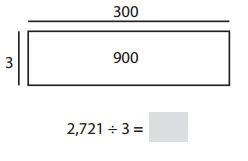
Answer:
The array to find 2,721 ÷ 3.

Question 4.
What is the length of a rectangle that has an area of 2,721 ft2 and a width of 3 feet?
Answer:
907 feet.
Explanation:
Given,
Area of the rectangle is 2,721 ft²
Width = 3 feet
We need to find the length of a rectangle
2721 ÷ 3 = 907 feet
Question 5.
CHALLENGE What is the length of a rectangle that has a perimeter of 2,721 feet and a width of 3 feet? Show your work.
Answer:
1357.5 feet.
Explanation:
Given,
Perimeter = 2721 feet
Width = 3 feet
Perimeter of the rectangle is = 2 ( l + b)
2 (l + 3) = 2721
(l + 3) = 2721 ÷ 2
l + 3 = 1360.5
l = 1360.5 – 3
l = 1357.5 feet